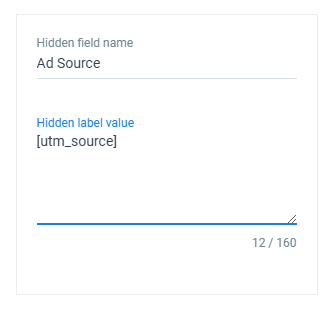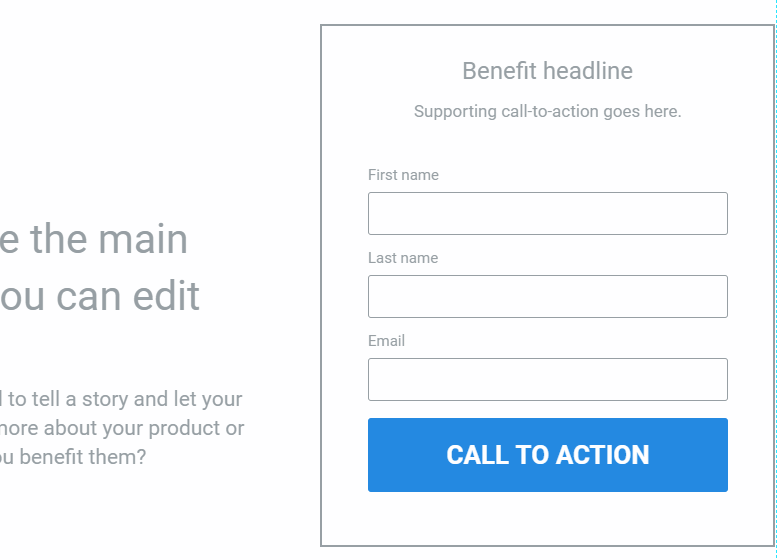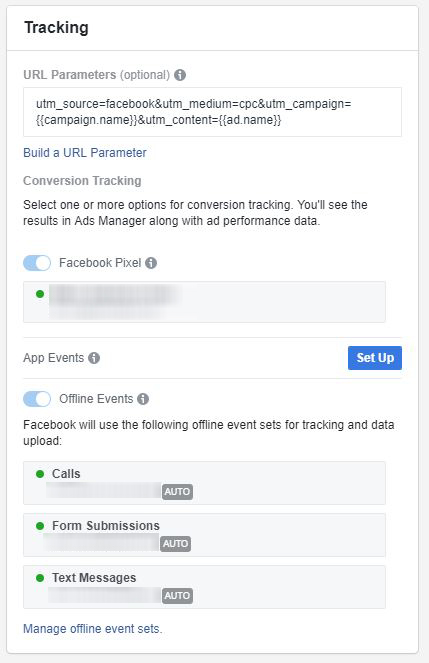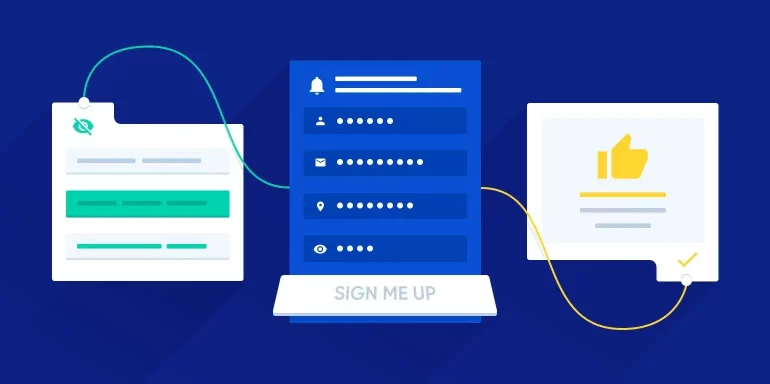- What are hidden form fields?
- Understanding hidden fields
- Setting up tracking parameters in Google Ads
- Adding tracking parameters to Facebook Ads
- 5 Benefits of adding hidden fields
- Optimize for sales
- Identify the highest quality traffic channel
- Put a stop to low-quality leads
- Discover remarketing opportunities
- More accurate testing
- Conclusion
Online forms are a great way to generate leads, but the form fields users see on the page are not the only valuable information you can collect. Additional details can give you more insight into prospects and help you convert more leads into customers in the long run – this is done with hidden form fields.
Whether you’re using Google Ads, Bing Ads, Facebook Ads, or any other PPC platform to generate landing page traffic, those details can often be found in hidden form fields.
What are hidden form fields?
Hidden form fields are exactly what they sound like — invisible fields users can’t see when they complete a form on your landing page. Just because they can’t see them doesn’t mean they aren’t important:

These hidden input fields are automatically populated by the UTM parameters in your URL tracking templates. These UTM parameters help you capture user data who complete your form. You’ll find out which traffic channels perform best, what keywords turn into sales, and much more.
What are some of these UTM parameters and what do they mean? Here’s a short list.
- UTM_SOURCE: Where the user originally clicked to find your website or landing page
- UTM_MEDIUM: How the user came to you, i.e. social
- UTM_CAMPAIGN: The stage of the sales funnel, i.e. awareness
- UTM_TERM: The keyword the user searched to land on your site
- UTM_CONTENT: The type of content, like a blog post or Quora answer, the user clicked on
- INITIAL REFERRER: Where the user came from first, i.e. Google
- LAST REFERRER: The last referrer for that user, i.e. LinkedIn or Reddit
- LANDING PAGE: Where they landed on your site initially, from the home page to a landing page or blog post
- VISITS: How many times they visited your site or landing page before they completed your form
Here’s how you can use these hidden input fields and UTM parameters to optimize your PPC campaigns and see the best return on ad spend you’ve ever seen.
Understanding hidden form fields
The fields are populated by cookies used on your site and can provide you with a lot of data about your new lead.
There are several advantages to collecting this data with hidden fields versus asking customers directly. For instance, to know where your leads are coming from, you can add a “Where did you first hear about us?” text field on your form. However, not everyone chooses to fill out this entry, and often, they don’t remember how they originally heard about you in the first place. It might have been a Google search, a Facebook ad, a display ad, or from other content.
Hidden fields tell you exactly where they came from without relying on the users’ memory or desire to fill that in.
Instapage makes it quick and easy to add hidden form fields to your landing page. Simply select your form, click add field, and select hidden from the dropdown menu:

For them to work, you must add UTM form scripts to your website. The code is placed before the final tag at the bottom of every page on your website. So no matter where the user lands first, the data will be exported to your form. It will look something like this:

There are additional codes you can add if you need advanced tracking. They can be added using the Google Tag Manager or by making changes to your website itself.
Hidden field forms are really easy to manage in Instapage as well. This quick article explains how using Dynamic Text Replacement.
Setting up tracking parameters in Google Ads
ValueTrack parameters work with Google Analytics or other tracking solutions to analyze your specific Google Ads campaigns, Facebook Ads, and other PPC campaigns. Adding them to your campaigns is easy, and like other UTM form script, you must add a special script to your ad’s target page to gather the data.
What are these parameters? Here are a few you can add to your ad campaigns and why they matter.
- {matchtype}: This tells you how well the keyword triggering the ad matched the one you originally targeted. The results will either be “exact phrase match”, “broad”, or another advanced match type. This helps you better target your keywords to those that are bringing in conversions.
- {network}: Where was the ad clicked? Google, a Search Partner, or a publisher site? This tells you whether search partners are adding value to your ad campaigns or if you can reduce or eliminate your spend on them.
- {keyword}: Enables you to tie a specific keyword string to a lead. This means you can figure out the value of a set of keywords over time, and make adjustments to future ad campaigns as needed.
- {adposition}: This is where your ad appeared on the Google SERP, and can illustrate that if you are getting high-quality conversions in a mid-page position, it may not be worth the expense to reach higher ad positions.
Other ValueTrack parameters
There are several other ValueTrack parameters you can add, and you can find some of them here. How do you set them up? In Google Ads, you can either set up a tracking template that applies to all campaigns, or set up custom parameters for each ad. For ad level tracking the setup looks like this:
![]()
You can also set up account-level URL tracking parameters instead of adding them to each ad individually.
Here’s a pretty solid tracking code to help get you started.
{lpurl}?utm_campaign={campaignid}&utm_source=google&utm_medium=cpc&utm_content={creative}&utm_term={keyword}&adgroupid={adgroupid}
Copy and paste the code above in your Google Ads account settings page. Then proceed with Campaigns > Settings > Account settings tab, and paste the code into the tracking template field:
![]()
Once the code is pasted in the tracking template, Google Ads will automatically append this to all URLs in your account.
Adding tracking parameters to Facebook Ads
You can add these same tracking parameters to your Facebook ads to ensure the proper information is passed on to your hidden form fields.
Facebook has a built-in builder that will help you create tracking parameters for your ads. It even gives you the option to have the UTM parameters dynamically populated for each relevant field:
![]()
However, the builder is a bit limited so you may want to add your own parameters as well:

Once you’ve filled in all of the tracking parameters you wish to add, you should see something similar to the above screenshot.
This URL parameter will now be added whenever someone visits your website or landing page via your Facebook ad. Likewise, your hidden form fields will capture this data when the user completes your form.
5 Benefits for adding hidden fields
What does all this work get you? Here are five benefits that make setting up hidden fields and ValueTrack parameters worthwhile.
1.Optimize for sales
Since hidden fields help you determine the keyword or placement that triggered the ad and brought the user to your site, the next question is, “What was the end result?”
Did they become a productive lead and make a purchase?
Unlike ecommerce, lead generation campaigns produce leads, not sales, which means the sale often takes place at a later date. So wouldn’t you want to know which keywords, placements, and audiences are producing sales?
Hidden input fields make it possible for you to track which keywords, placements, and audiences led to a sale. This means you can optimize your account for sales, not just leads.
Most PPC marketers optimize for conversions with a static cost per conversion goal regardless of the quality and value of the conversions. This mindset would lead you to believe that keyword 1 (below) is the clear winner. It has a higher conversion rate and a lower cost per conversion making it the obvious choice:

However, a quick glance at the next table should change your mind:

After reviewing the data captured by your hidden form fields you find that Keyword 2 actually costs you far less per sale. Which means it’s making you more money and that’s what matters.
The data captured by hidden fields allow you to see which keywords have better sales potential. Over time this information will help you make smarter optimizations and budgeting decisions.
2. Identify the highest quality traffic channels
This leads us to high-quality traffic channels. In other words, referrals that bring you more than just leads or traffic, but actual sales and the best ROI.
The same analogy we used in the previous section applies here as well, but in a broader sense.
Let’s say you’re advertising on Google and Facebook. Your Google Ads account averages a cost per conversion of $50 and 50% of them turn into sales. Meanwhile, your Facebook Ads might be bringing in conversions for $10, but if only 1 in every 20 turns into a sale, then you may consider investing more heavily in Google Ads.
The data gathered in hidden fields lets you make better, data-driven decisions about which platform to focus your ad spend on and which channels are a lower priority.
3. Put a stop to low-quality leads for hidden form fields
The data you gather in hidden form fields helps you identify and stop underperforming campaigns, ads, keywords, placements, and audiences before they deplete your budget any further.
For example, you may be getting hundreds of leads each month from your Google and Facebook ads, but only a handful of those leads turn into sales. It’s easy to write this off by setting low expectations, but have you considered…
How much time and money you’re wasting with these low-quality leads?
If you have, then chances are you’d like to put a stop to them and use your ad spend more efficiently.
Hidden form fields can help you spot lead quality trends and weed them out. For instance, if you find that a certain keyword produces leads that can’t be contacted or rarely turn into paying customers, then you can adjust accordingly.
Without the data from hidden fields, you could be duped into increasing bids and budget on these wasteful campaigns, ads, keywords, placements, and audiences.
4. Discover remarketing opportunities
You can look at the combination of traffic channels and keywords that have a longer sales cycle. This lets you focus on hyper-specific remarketing efforts. By looking at the hidden field data and combining it with your site analytics, you can determine the right blend to produce amazing results.
For example, the keyword “digital marketing strategy” persuaded the most CMO’s of a certain sized company responding to your LinkedIn ads. A significant percentage of those CMO’s became not only one-time clients but also signed long term contracts with your company. This is an opportunity to target a very specific audience with a very specific strategy aimed at long-term results and increased customer lifetime value.
This type of data allows you to create unique remarketing messages for each traffic channel instead of taking a one size fits all approach.
You may also find that some campaigns have a longer sales time lag while others take only a day. So instead of a generalized remarketing campaign, you could use remarketing budget more wisely by focusing remarketing to the campaigns with longer sales lag time.
This more precise approach to remarketing helps to shorten your sales cycle and prevent wasted budget on conversions with little to no sales lag.
5. More accurate testing
A/B testing ads can help you identify the ads that perform best. However, the results displayed inside your ads account could be misleading.
For example, you may see that one of your ads has a higher conversion rate than the other, but without hidden fields, you have no way of knowing which ad generates the most sales:

Hidden fields offer you the best opportunity for more accurate testing. It goes beyond A/B testing how many conversions your ad brings in and helps you measure the quality and sales potential each ad possesses.
The more data you have, the more accurate your testing. You can know for sure which ads bring more sales and profit, not just clicks and conversions.
Conclusion
Hidden form fields are a CRO gold mine. They can tell you more about leads that convert than your ad platform and analytics combined. You can customize hidden fields with the data you require to make the smartest marketing and advertising decisions.
It doesn’t matter where you’re running PPC campaigns. Hidden form fields help you track the success of your paid search and social campaigns, from campaigns, to ads, to keywords, and more. You’ll be better informed about who converted, how they converted, and why they converted. All this data helps you better allocate marketing budget, preventing wasted ad spend, and maximizes high-quality conversions that result in sales.
Turn ad clicks into conversions, create dedicated, fast-loading pages for every offer. See how to provide all of your audiences with unique landing pages by signing up for an Instapage 14-day free trial today.
About the author
Luke is the founder of Linear, a Utah-based PPC agency with an intense focus on conversion rate optimization. Luke and his team have helped hundreds of their clients increase conversion rates, grow their business, and greatly improve their ROI. Connect with him on Twitter, LinkedIn, or get a free proposal.

Try the world's most advanced landing page platform with a risk-free trial.
